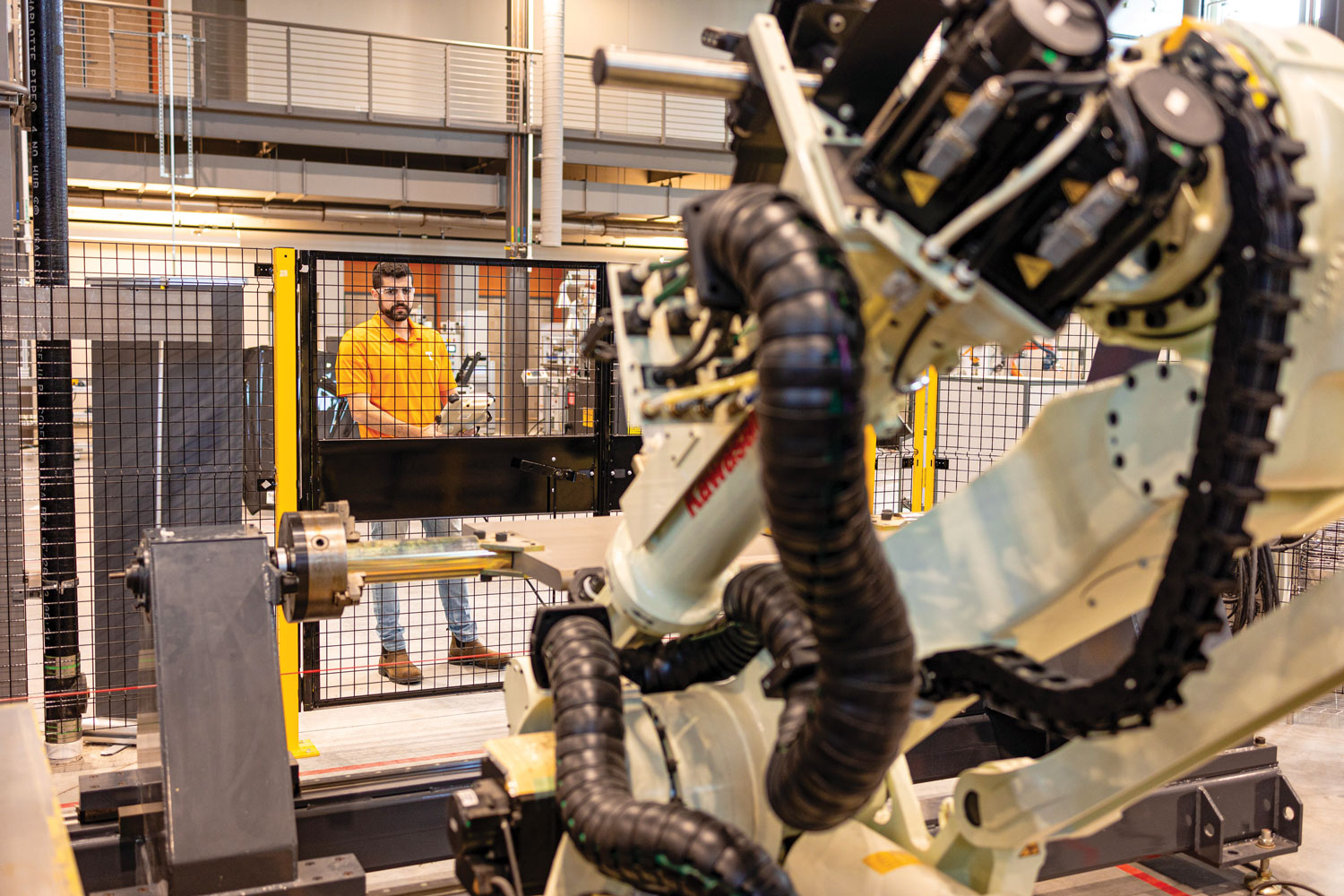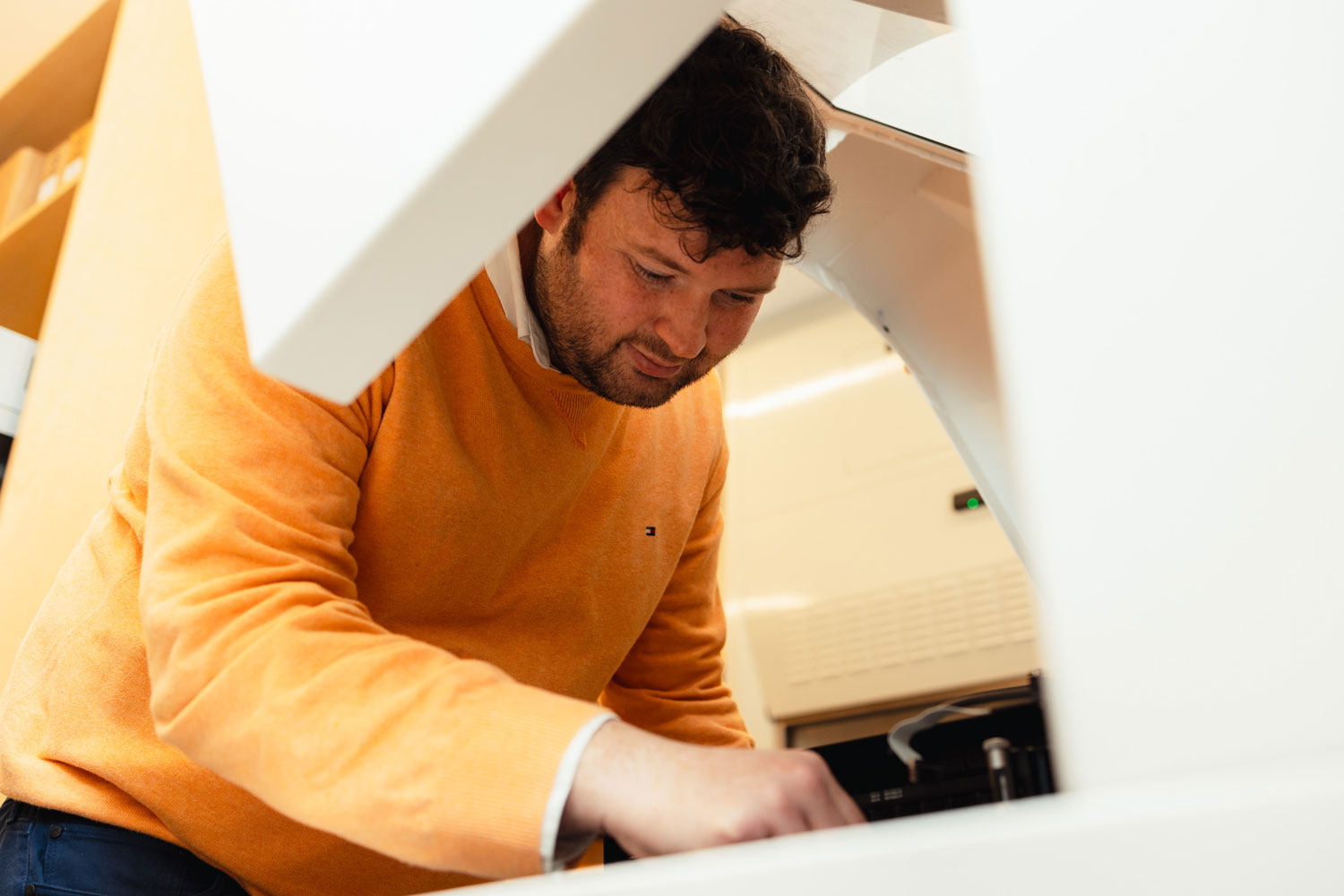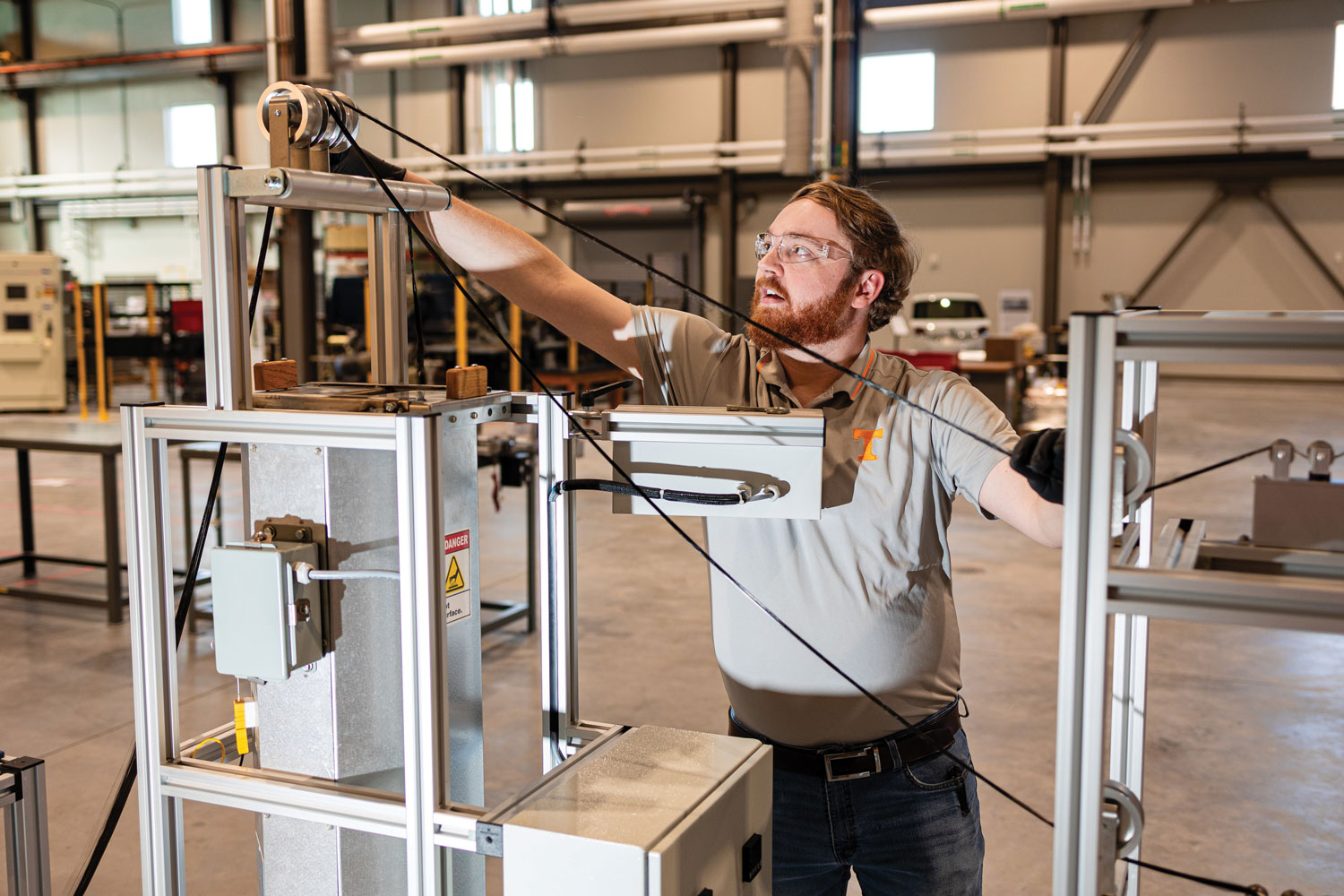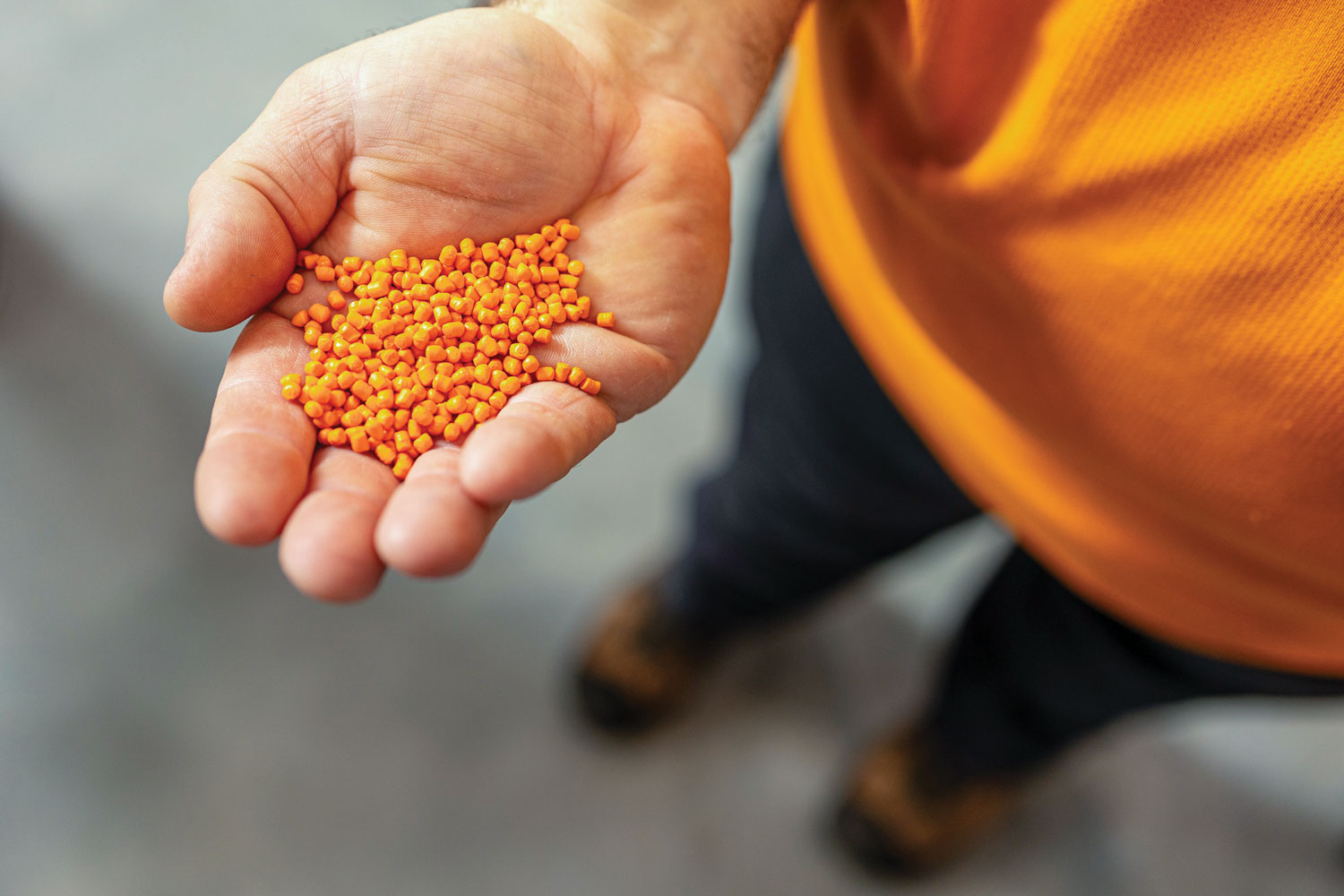UT’s Manufacturing Ecosystem
A decade-long dream conceived to showcase the manufacturing might of the University of Tennessee has sprung to life at UT’s Research Park at Cherokee Farm. Innovation South is an 85,000-square-foot multi-use facility that serves as a composites manufacturing ecosystem.
The dynamic workspace, which opened last October, brings together researchers, students, and industry for a one-stop shop of manufacturing development and workforce training that will provide an economic benefit to the state, the Southeast, and the country.
“Collaboration matters,” said UT-ORNL Governor’s Chair for Advanced Composites Manufacturing Uday Vaidya, who proposed the idea of Innovation South when he first arrived at UT in 2015. “A shared vision between industry, academia, and government drives research, commercialization, and jobs. Innovation South enables us to develop materials-by-design solutions that will reduce the cost, energy, and manufacturing time of next-generation products.”
Developed and owned by Partners Development, Innovation South includes a 40,000-square-foot high bay and laboratory space for UT faculty, students, and industry collaborators to conceptualize, prototype, and test sustainable composite materials for advanced manufacturing, including precision agriculture, architecture, aerospace, and automotive applications.
Faculty and students from the Tickle College of Engineering, College of Architecture and Design, and Institute of Agriculture all have a presence at Innovation South. The facility is also home to the UT’s Fibers and Composites Manufacturing Facility (FCMF) and serves as the headquarters for IACMI-The Composites Institute, a 140-member consortium of companies. In a unique public-private partnership, UT researchers and students work side-by-side with industry partners on new innovations.
“The size of space and the scale that we’re going to be able to do things is very beneficial,” said David Harper, a joint professor in the Department of Materials Science and Engineering, who is working with natural fibers, natural polymers, and bio-based materials to help support agriculture and farmers. “The synergy of having the different groups in the same space is always a good thing to collaborate and get things done. Hopefully, we can then share resources and have everything right there in one space.”
Equipped for Success
Innovation South is filled with state-of-the-art, world-class equipment that enables researchers and industry partners to utilize the full life cycle of materials. They can manufacture and test materials such as advanced composites created from low-cost fibers and fast-curing resins to produce value-added products for a range of sectors, including aerospace, automotive, energy, and industrial applications.
The Michelman Fiber Sizing Line is a 70-foot modular system designed to apply a variety of fiber sizings, a very thin chemical coating that serves multiple benefits in manufacturing. UT students are involved in each project conducted on the sizing line.
“This sizing line is one of the most unique in the country. It allows us to do a lot of customized chemistries and a lot of customized things with fibers to make an interface critical,” said Krishnan Veluswamy, an assistant professor in the Department of Material, Aerospace and Biomedical Engineering. “This was a black box before. Nobody had this machine. Now, we have the machine, and we have different companies lining up to work with us.”
The sizing line has greatly benefited Dayakar Penumadu, the Fred N. Peeples Professor and IAMM Chair of Excellence in the Department of Civil and Environmental Engineering, and his research work with carbon fibers and glass fibers. The resources at Innovation South have made the timeline to develop prototypes much shorter.
“We can now create some custom interfaces on these fibers to stick or adhere well to the composite resin of a matrix, and then we can do different tests on them to see how those properties have improved,” Penumadu said. “As a result, we’re making some next-generation material systems that very, very few universities can do today.”
Among the other machines located at Innovation South are:
- High speed Wabash compression presses (100 ton, 150 ton, 500 ton)
- RocTool induction heating system
- Automated tape placement system
- Natural fiber matmaking and spinning line
- Multi-axis freeform robotic machinery
- CNC Router
- Extrusion Plasticator
- Haas VM-3
“They have everything that you would need to go from start to finish in a composite material,” said MSE Assistant Professor Dustin Gilmer. “That can sometimes involve multiple manufacturing processes, all the way to machining and other aspects of the process. Innovation South is a centralized location to show all of that in one area.”
Enhanced Student Experience
Innovation South is expected to have 50 UT graduate and 100 undergraduate students working on projects any given semester, along with 15 post-doc students. An additional 50 to 100 student workers will be coming through the facility for training each year.
Rather than being siloed during their work in a lab or classroom, the UT students will gain exposure to industry partners that will make them more marketable to companies once they graduate.
“There are very few places in the U.S. for students that can actually have experience in manufacturing at any kind of scale. That will be unique to us,” Harper said. “From the start to the finish of manufacturing, students can get a more holistic view of the experience.”

Josh Gilder spent two years as an undergraduate working at the old FCMF facility. Being able to work with Gilmer’s group at Innovation South has been a major upgrade with space and access to equipment.
“One thing I’m most excited about is the machine that I make samples on for my graduate research was housed at IACMI’s Checkerboard facility because it couldn’t fit at FCMF. Now with the added space, that machine, as well as filament winders and presses I’ll be using, have all been moved to the same location,” Gilder said. “This will save me time and allow me to get more, and higher-quality research done.”
As companies seek to expand their workforce, they are telling UT professors what is needed from potential employees to ensure their long-term success.
“Our students and our graduates need to experience manufacturing and the integration of materials manufacturing at scale,” Vaidya said. “They need to be trained so when they go to industry, they are ready for it, because they will already have worked on things at Innovation South that they will encounter right away.”
Essential Industry Collaborations
Innovation South’s occupants are working collaboratively on breakthrough technologies to test and bring to market, particularly in cleantech and advanced composites sectors. Industry partners at the facility include Cherokee Farm Development Corporation, New Day Diagnostics, Trimble, and the U.S. Forest Service.
Through the full integration of research and industry under one roof, the entities involved can learn from each other while they work together.
“A lot of stakeholders can be engaged. There’s so many undergraduate students engaged in the activities, experiential learning, job creation. There’s also a lot of small company engagement through the Innovation Crossroads and the Bredesen Center and the Sparks Accelerator programs,” Vaidya said. “It’s a conglomeration of these connections that make it very powerful.”
The process flow at Innovation South works like industry by moving up in stages. The equipment stations in FCMF are positioned to mimic and test the full chain of industry processes. They include pellet production; sheet, compression, and injection molding; large-area additive manufacturing; automated tape placement, braiding and winding; laser cutting and performing; shredding and recycling.
One thing I’m most excited about is the machine that I make samples on for my graduate research was housed at IACMI’s Checkerboard facility because it couldn’t fit at FCMF. Now with the added space, that machine, as well as filament winders and presses I’ll be using, have all been moved to the same location.”
Innovation South should help UT researchers avoid the “valley of death,” when a project reaches a technical readiness level (TRL) of 2 or 3 and then fizzles out because it can’t get the support needed to reach a higher TRL for companies to invest in a prototype.
“All major schools have a lot of good innovations, but they never see the light of day,” Panumandu said. “Innovation South will help us bridge our ability to go from concept to a part because of all the collaboration and equipment in the facility.”
From the time they broke ground on Innovation South to the time they cut the ribbon for the official opening, Vaidya played an instrumental role in shepherding the process to the finish line. The result is a facility that further enhances UT’s distinguished reputation for advanced materials and manufacturing.
“I really think it is a vision come true, and without the UT admin and the support, this would not be possible,” Vaidya said. “I think we have created something that will be used by generations to come, and it’s only going to add lot more value to the university at large.”
Check the Stats
The new Innovative South facility is designed to support teams of faculty, student, and industry collaborators with cutting-edge equipment. Take a look at some of the features of the new facility below:
85,000
square-foot multi-use facility
- David Harper
- Dayakar Penumadu
- Uday Vaidya
- Dustin Gilmer
- Krishnan Veluswamy
- Cherokee Farm Development Corporation
- IACMI
- New Day Diagnostics
- Spark Innovation Center
- Trimble
- U.S. Forest Service
40,000
square-foot high bay and laboratory space
- Tickle College of Engineering
- College of Architecture and Design
- College of Education, Health, and Human Sciences
- College of Emerging and Collaborative Studies
- Institute of Agriculture
- School of Art
50+
students hired
- Automated Tape Laying Facility
- Compression Molding Facility
- Fiber and Polymer Reinforced Composites Characterization Facility
- Fiber Sizing Line
- Injection Molding Facility
- Robotic Filament Winding Facility
- Sheet Molding Compound Line






